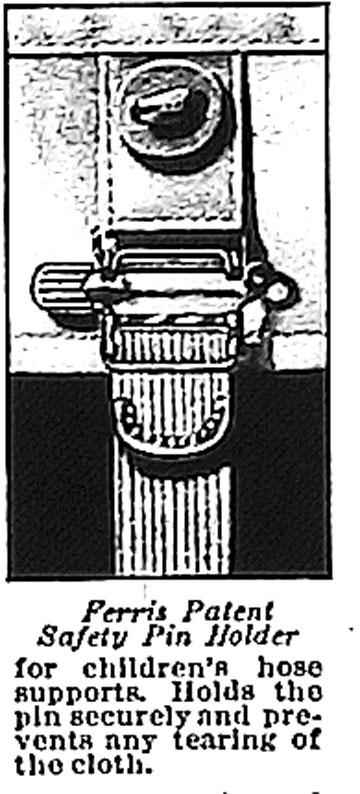
Ferris Good Sense Waists: Pin Fastners (1906-07)

Figure 1.-- An ad in The Youth's Companion, which appeared in March, 1906, p. 11, illustrates the fastener used in the Ferris Good Sence Waist. A 1907 advertising text in the same periodical mentions "Fasteners for safety pins that prevent tearing". The Ferris Common Sense Waist, which was manufactured in different models for both boys and girls, had garter tabs at each side located directly beneath one of the waist buttons. The tab was a heavy piece of cotton tape with a metal device at the end through which the safety pin of the hose supporter could be inserted and locked in place.
|
|
An ad in The Youth's Companion, which appeared in March, 1906, p. 11, illustrates the fastener used in the Ferris Good Sence Waist. A 1907 advertising text in the same periodical mentions "Fasteners for safety pins that prevent tearing". The Ferris Common Sense Waist, which was manufactured in different models for both boys and girls, had garter tabs at each side located directly beneath one of the waist buttons. The tab was a heavy piece of cotton tape with a metal device at the end through which the safety pin of the hose supporter could be inserted and locked in place. The device was patented by the Ferris company and referred to as the "Ferris Patent Safety Pin Holder" It was invented to hold children's hose supporters firmly in place. The text says that the fastener "Holds the pin [of the supporter] securely and prevents any tearing of the cloth." In some more primitive underwaists for children, the garters were pinned directly onto the waistband of the underwear and could tear away from the garment during rough and ready play or athletic activity. This Ferris fastener seems to have been the ancestor of the "pin-tube" that later waists and waist union suits adopted as a means of securing hose supporters. The Nazareth Waist Company, for instance, used pin tubes. The E-Z Waist Company (the competing firm), however made a point of avoiding metal tubes on waists because they could get crushed in the wringers of washing machines or perhaps rust during laundering. The E-Z company used tape loops instead of metal pin tubes as holders for the hose supporters. This illustration gives us a bit more insight into the developing technology of holding up long stockings in the first decade of the 20th century.
HBC

Navigate the Boys' Historical Clothing catalog/magazine pages:
[Return to the Ferris Good Sence waist
[Return to the Main 1907 catalog page]
[Return to the Main 1900s catalog page]
[Main photo/publishing page]
[Store catalogs]
[Fashion magazines]
Navigate the Boys' Historical Clothing Web Site:
[Introduction]
[Activities]
[Biographies]
[Chronology]
[Cloth and textiles]
[Clothing styles]
[Countries]
[Topics]
[Bibliographies]
[Contributions]
[FAQs]
[Glossaries]
[Images]
[Links]
[Registration]
[Tools]
[Boys' Clothing Home]
Navigate the Boys' Historical Clothing Web Site:
[Sailor hats]
[Sailor suits]
[Buster Brown suits]
[Eton suits]
[Rompers]
[Kneepants]
[Knickers]
[Tunics]
[Smocks]
[Pinafores]
[Long stockings]
[Underwear]
Created: 5:31 AM 1/11/2008
Last updated: 5:31 AM 1/11/2008



